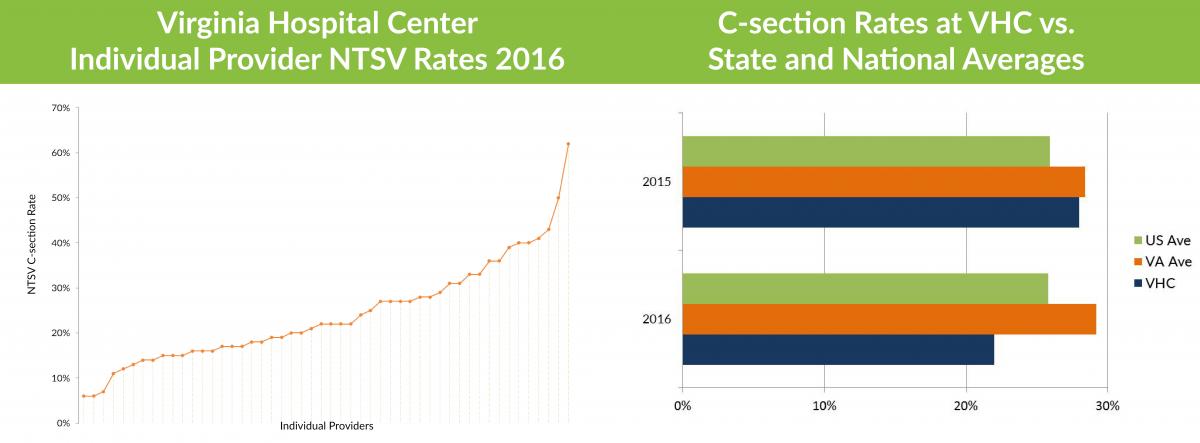Background: C-Section Rates Above National Targets
Childbirth accounts for the majority of all U.S. hospitalizations among privately insured women ages 19-44. While hospitals across the country have been making steady progress in meeting national maternity care standards, more work needs to be done, particularly when it comes to Cesarean section rates.
As part of its mission to improve the quality and safety of hospital care, Leapfrog tracks the C-section rates of individual hospitals across the country through the Leapfrog Hospital Survey. According to Leapfrog’s 2017 Maternity Care Report, the average rate of NTSV (Nulliparous, Term, Singleton, Vertex) C-sections nationwide is 25.8 percent, representing minimal improvement from the rate of 26.4 percent in 2015 when Leapfrog first began reporting this data. This figure is above Leapfrog’s target rate of 23.9 percent or below, set by its national maternity care expert panel.
In certain instances C-sections are necessary, but generally vaginal births are much safer for low-risk pregnancies. According to the American College of Obstetricians and Gynecologists (ACOG) and the Society for Maternal-Fetal Medicine, for most pregnancies, caesarean delivery poses greater risk of maternal morbidity and mortality. C-sections carry serious risks of infection or blood clots and many women experience longer recoveries and difficulty with future pregnancies. They can also cause problems for babies, such as breathing difficulties that need treatment in a newborn intensive care unit (NICU).
C-Section Measurement Galvanizes Improvement
After compiling data for the 2014 Leapfrog Hospital Survey, Virginia Hospital Center (VHC), a 394-bed, not-for-profit, teaching facility serving the Washington, D.C., metropolitan area, learned its NTSV C-section rate was 33 percent, far above Leapfrog’s target rate of 23.9 percent. According to Dr. Jeffrey DiLisi, Senior Vice President and Chief Medical Officer at VHC, the immediate reaction from senior leadership was, “That’s not who we are. We’re about putting the patient first and this is a big issue.” To better serve its community, the hospital aimed to prioritize and address this issue head on.
Taking Action
VHC embarked on a multi-year initiative to lower its C-section rate. The hospital reviewed a new recommendation from ACOG and the Society for Maternal-Fetal Medicine that stated nonintervention in the latent phase of labor reduces the risk of cesarean delivery. With this in mind, VHC took several steps, including:
- Forming a multidisciplinary working group to track progress
- Implementing chart audits and educational activities
- Encouraging transparency by posting C-section rates at department, group and individual levels
- Working closely with practitioners who needed help lowering their rates and incorporating corrective measures for persistent outliers

To encourage transparency, VHC posts C-section rates at department, group and individual levels, as pictured above.
The graph to the right compares VHC's NTSV C-section rate to the state and national averages.

Three years later, VHC is delivering on its promise to reduce unnecessary C-sections. The current rate (20.9 percent) is lower than both Leapfrog’s standard and the rate among surrounding hospitals. “No one likes transparency at first, but there are two ways of dealing with it: do nothing and continue to perform poorly, or fix the problem and improve. Ultimately, transparency improves outcomes,” says Dr. DiLisi.
The Leapfrog Hospital Survey
In 2016, over 1,850 hospitals submitted a Leapfrog Hospital Survey, a national nonprofit initiative conducted on behalf of hundreds of employers and other purchasers of health care across the country. Purchasers and national health plans request that all general acute care and pediatric hospitals in the U.S. complete the annual survey, and reports those that opt out as “declined to respond.” Results compare quality and safety, reported by hospital and used for public reporting and payment strategy. Reporting to the survey is free for all hospitals and the results are free to the public.
For more information on completing the Leapfrog Hospital Survey visit www.leapfroggroup.org/survey.

